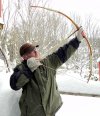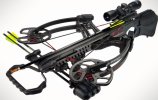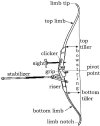Corvus
Dagobah Resident
I do agree with you on relaxed breathing, deep breathing (pipe breathing perhaps? :) ) though Olympic Silver Medalist, Jake Kaminski says the order is 'pull back, relax, aim and let go'
On second thought, a deep breath might just be enough to relax as there's not much time and also, by relaxing we can reduce the tension in most of our body but not in the drawing arm/shoulder.
Same is with firearms, standard procedure is to inhale then hold your breath while aiming and pulling trigger, then exhale after that. Depending on situation and if you have time(like in hunting) you pull trigger spontaneously to surprise you in a way, because knowing can disrupt concentration and aiming. Holding to long your breath can increase hearth rate and also disrupt aiming. Also fast triggering can move rifle and disrupt aiming because of jerking so it is essential to hold it tight. It is different in a way then archery but it is practically the same with breathing but it depends from person to person essentially.
I never used real bow but know that it had profound affect on warfare from my studies of ancient and medieval warfare and I had also master work on Achaemenid Persia and there was and section about it s military. Archery was very praised in that parts in the world, especially in ancient and medieval time. In the west, if we take for example Greece that was center of west militarly, culturally, etc.. in that time before Rome, archery was used very little and Greeks preferred hand to hand and looked at archery as cowardly way of fighting. When it came to ranged fighting they used mostly singers and Cretans were known for their archery skill and were used as mercenaries through whole Greece and in Roman time. Persian tactic was on the other hand based mostly on archers disrupting enemy lines and rest of infantry and cavalry finishing the job. But when it came to Greco-Persian wars they did not have yet composite bows that could go through armor because of their high penetration power so arrows did not do much to penetrate hoplite lines and their armor, and their heavy cavalry was dealt with when Philip, Alexander s father created phalanx formation. In the time of Parthia and it s wars with Rome (that used very few archers at first, mostly infantry, Caesar used Cretans against Gauls) it perfected it s archery thanks to composite bows that was brought by raids of nomadic Alans. Cavalry and archery tactics were brought in those areas thanks to nomadic people s from Central Asia, Scythian tribes, even in the time of Achaemenids Scythian tribes gave best cavalry units that made basis for later knights because they also brought scale armor and fully armored horses and mounted warriors, and they made best warriors in their army like Bactrians, Messagetes(although many western scholars will deny it because of their western centralized egos and west is always the source of everything and anything). Parthia perfected horse archery with composite bows and heavy cataphract tactic and brought heavy loses to Romans, famous being Crassus defeat against all cavalry Parthian army. Their tactic was being that of mounted archers firing volleys of arrows on enemy and causing high casulties and if enemy like Romans tried to engage, they would retreat and fire in return and in that way causing also great damage to pursuing infantry. They would also try to lure units to come following so the cataphracts would then surround them and break them or would wait for lines to weaken from constant arrows and charge them. They even have logistics that was delivering those arrows all the time when in battle. Romans had very hard time dealing with that tactic and there would pass some time before they started to use composite bows in larger numbers and copy cataphract cavalry but still did get bigger end most of times.
Sassanian Persians continued with that tactic against Byzantine Empire and got to conquer all the Syria, Palestine, Egypt, larger part of Asia minor from Romans(although t for short time) and besiege Constantinopolis with Avars. it s big three layers walls saved it as many times later(with Greek fire) during Arab invasions(and it was still to strong). Emperor Heraclius managed to organize counter offensive against tired Persia and free that areas and force Persian shah to sign peace. In the meanwhile Arabs prepared and used that situation that both sides got exhausted from fighting and began their conquest. Arabs had their own tradition of archery but with Turks Seljuks that used extensively horse archery and were most famous for it at the time and defeated Byzantines and others many times. Byzantines on the other hand had open mind to applying new tactics and used also horse archery very much, they used Turk and Alan mercenaries, Cum ans, etc... In Gesta Francorum there is description of some Crusaders first coming in contact with such warfare with Turks. After their howling like wolfs and volley of arrows many wounded and knocked out retreating and commenting how would they not because this warfare was new to them. Mongols used similar tactic as Parthians, Sassanian s and other Asian step people and laid waste to European and other armies. Mameluks, personal bodyguards and cavalry of Egyptian Ayyubid sultans (most known being Saladin) were also trained in archery from childhood because they were Turkish slaves like Ghulams units that were known through middle east at that time.
Europeans did use very little archery in comparison, in western Europe horse archery was practically non existent, relaying mostly on knights and heavy infantry, spear-men. Hungarians and Bulgar s used horse archery because of their steppe origins, Byzantines because their constant clash with such armies and Russians because of being on frontier with central Asian steppe people, wars with them and Mongols. Other Slavic south and eastern European people also used horse archery. I know English long bowmen were also known for their contribution in Henry V s victory at Agincourt against larger and stronger french knight army because they penetrated easily their armor, flower of french nobility being subdued by ordinary peasants or something like that was the story, same with gun-powder which was first recorded as being used in same battle. Horse archery and archery was common in east among steppe people: turko-mongolic people and Indo-european people in the east. Only way to counter such tactic is by using same or many foot archers, cavalry, spear men, and use terrain where horses can not easily escape or move.
Thanks for sharing.








